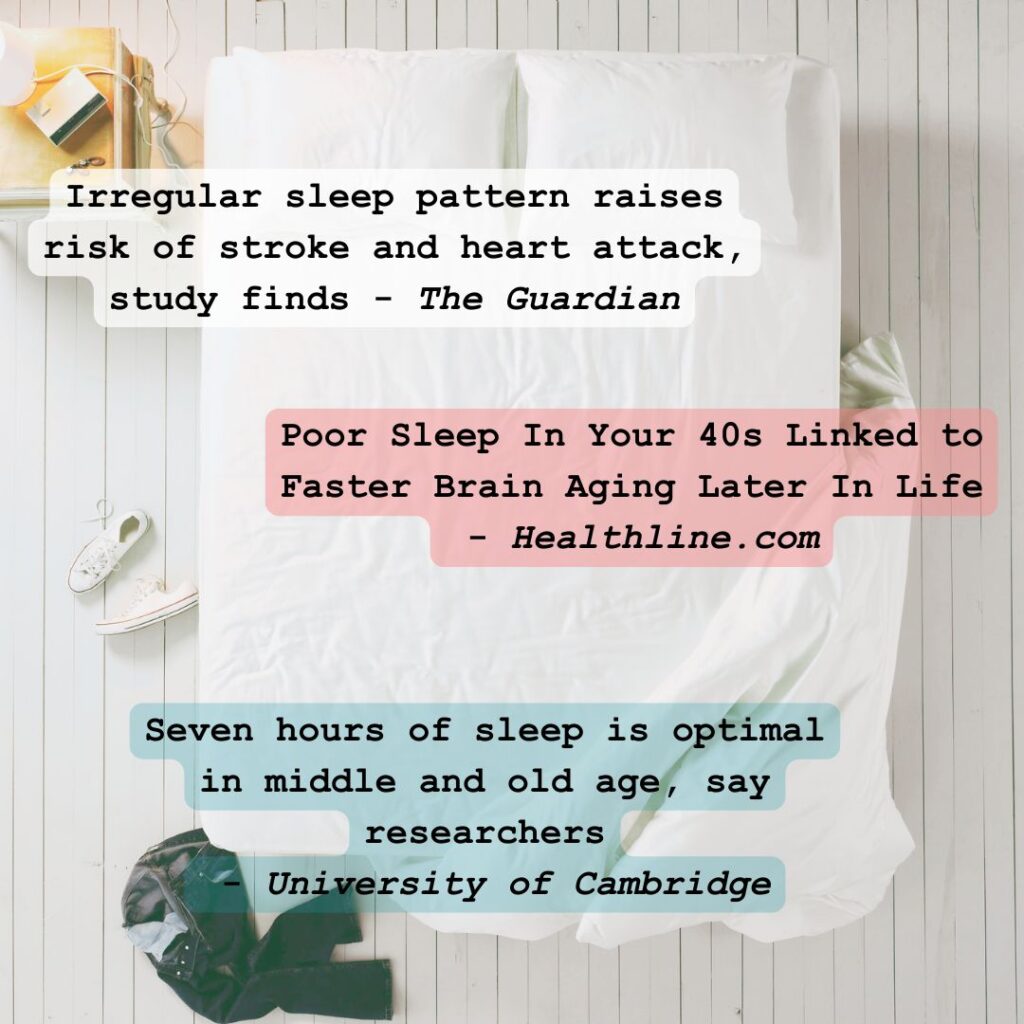Until recently, I was really struggling with poor sleep. I could fall asleep, but staying asleep? That was another story – not just midlife interrupted, sleep interrupted too!
Right now, I seem to be in a bit of a reprieve and really enjoying improved sleep quality, but let’s be realistic —I know these sleep interruptions will likely return from time to time. Thankfully I now feel much better equipped to manage these periods of insufficient sleep and I now face them with more wisdom and less anxiety. But its been a journey to get there…..


The relentless pressure to get enough sleep
Whilst I was experiencing lack of sleep, I became more and more aware of the all the messages proclaiming quality sleep in middle age to be the to ultimate key to healthy aging.
I get it—there’s nothing better than a good night’s sleep – waking up feeling fully refreshed and like you’ve had enough sleep. But the relentless pressure to get the perfect amount of sleep, 7-9 hours a night, was stressing me out when I could barely clock in four hours before waking up.
Since HRT isn’t currently an option following my cancer-induced menopause, I’m especially conscious of managing my risk for age-related conditions – from heart health to bone density and cognitive decline. Adding sleep anxiety as well as scary messages about the impact on brain health, cognitive health and potentially, although research is limited, an increased risk of dementia and Alzheimer’s disease into the mix? Not helpful.
My (Messy) Sleep History
I’ve never been the world’s best sleeper, as an adult anyway. Before 40, I prioritised dancing until the early hours over a full night under my duvet. My sleep patterns were erratic, but I got by and didn’t need much sleep to function and even thrive. I was expert at a weekly 12-hour sleep binge to reset my system.
Post-40, however, things changed. I started valuing restful sleep and would look forward to an early night, but my body had other plans. Like clockwork, I’d wake up around 2-3 AM. I blamed hormonal fluctuations (thanks, perimenopause) and cortisol spikes due to stress. At other times I would experience bouts of restless leg syndrome – another delight of perimenopause affecting my quality of sleep.
When I was diagnosed with cancer, sleep became almost elusive as I processed the news. And it got worse as I navigated a medically induced menopause and the side effects of endocrine treatment – the hot flushes and night sweats meant I found it nearly impossible to have more than a few hours of sleep uninterrupted. I remained determined to try to improve this, exploring various lifestyle changes and developing new bedtime routines. I put a lot of effort in to try to get the magic 7+ hours.
The History of Sleep That No One Talks About
 Then I learned something fascinating: before electricity and artificial lighting, people didn’t actually sleep in one uninterrupted block. Biphasic sleep—a pattern of sleeping in two shifts—was completely normal. People would sleep for a few hours, wake up to eat or socialise (which incidentally makes me feel a teeny bit better about the midnight snacks I’ve become accustomed to), and then go back to sleep for round two.
Then I learned something fascinating: before electricity and artificial lighting, people didn’t actually sleep in one uninterrupted block. Biphasic sleep—a pattern of sleeping in two shifts—was completely normal. People would sleep for a few hours, wake up to eat or socialise (which incidentally makes me feel a teeny bit better about the midnight snacks I’ve become accustomed to), and then go back to sleep for round two.
So next time you find yourself awake in the middle of the night or needing an afternoon nap, just remember: if split sleep was good enough for our ancestors, it’s good enough for us.
How to Get the Best Sleep Possible—Even If It’s Not Perfect
I’ve learned: while the standard advice of 7-9 hours of perfect sleep sounds lovely, it’s not everyone’s reality – and that’s okay. Instead of stressing about hitting that “perfect” sleep target, I’ve focused on:
- How I feel when I wake up – I have stopped wearing a sleep tracker and I now measure how I feel instead. I realised these were becoming unhelpful – I would wake feeling refreshed and then my watch would tell me I’d had a terrible sleep and it changed how I felt.
- Celebrating good nights and hours and hours of sleep when they come.
- Developing a flexible approach to sleep that works with my body’s current needs -sometimes that means I enjoy an afternoon nap or a lie in.
- Creating a toolbox of lifestyle changes and products to support.
Here’s some of the things I’ve learned and am trying to improve my sleep hygiene and quality of sleep:
01
Create a Sleep-Friendly Environment
Keep it cool—temperature regulation is key, especially if you’re dealing with hot flashes or night sweats.
Invest in bedding that works for you—I use two wool duvets to accommodate my ever-changing temperature. A cooling pillow is also a game-changer.
Use blackout blinds—total darkness can make a big difference for deep sleep cycles. They are great in summer months too or if you need an afternoon nap.
Use lavender essential oil—a few drops on my pillow really helps me wind down.
02
Stick to a Routine
I try to stick to a sleep schedule – going to bed at the same time each night and getting up at the same time each morning. I have a night time routine which helps me wind down:
A warm bath – I have one most nights, it helps get the body ready for sleep by increasing body temperature which then cools quickly triggering sleepiness. I add a blend of essential oils too.
3 minutes of 4-7-8 breathing (inhale for 4 seconds, hold for 7, exhale for 8) – I do this at the same time as wearing my LED mask, habit stacking!
Journaling—I brain dump any worries before bed and celebrate the best moments of the day. I love this journal for free writing.
A few pages of a book (no screens!) – I’m currently reading This Could be Everything by Eva Rice – I’ve struggled recently to stay interested in a book, I hope this one is different.
03
Move During the Day
Exercise and physical activity can massively improve sleep quality, but timing matters, for me at least. If I work out too late in the day, it has the same effect as an evening coffee—wired, not tired.
04
If you need to, talk to an expert
If you suspect your sleep disturbances are hormone-related or due to another health problem, speak to your doctor.
- In the case of menopause and perimenopause there are various options – hormonal and non-hormonal.
- Some NHS trusts offer free access to Sleepio, an app based on cognitive behavioral therapy for insomnia (CBT-I).
05
What to Do When You Wake Up in the Night
If you wake up and can’t get back to sleep, try this:
Get out of bed briefly—keep the lights low and do something calming (no screens!). Reading, journaling, knitting, or even ironing can help.
Try relaxation techniques—apps like Headspace have great guided meditations for sleep.
Count backwards from 1000—I’ve never made it past 950 before drifting off again!
Listen to a podcast—one of my favourites is the Menopause and Cancer Podcast – Sleep episode. There are some really great expert tips.
Sleep in middle age might not always be perfect, we are human after all, and I’ve learned the worst thing we can do is stress about it.
If you’ve found any solutions that work for you, I’d love to hear them – comment below.
